Abstract
OBJECTIVE--To examine how exercise testing on background medical treatment affects the ability of the test to predict prognostically important patterns of coronary anatomy in patients with a high clinical probability of coronary artery disease but who are well controlled on medication. DESIGN--Prospective study. SETTING--Regional cardiothoracic centre and referring district general hospital. PATIENTS--84 patients with a history of typical angina or definite myocardial infarction and mild symptoms who had been placed on the waiting list for prognostic angiography. INTERVENTION--Maximal exercise electrocardiography and radionuclide ventriculography performed off and on medication, followed by angiography within three months. MAIN OUTCOME MEASURE--Prognostically important coronary artery disease for which early surgery might be recommended purely on prognostic grounds, irrespective of symptoms. RESULTS--Coronary artery disease was present in 71/84 (85%) patients; in 28/84 (33%) patients this was prognostically important. When the result was strongly positive, the predictive accuracy for prognostically important disease was 0.46 off and 0.62 on medication for the exercise electrocardiogram and 0.71 off and 0.82 on medication for exercise radionuclide ventriculography. The likelihood ratio was 1.00 off and 1.36 on medication for exercise electrocardiography and 2.54 off and 10.5 on medication for exercise radionuclide ventriculography. In stepwise logistic regression, the test identified as the strongest predictor of prognostically important disease was exercise radionuclide ventriculography on medication for which the improvement chi 2 was 28 (p < 0.0001). With the regression model, the probability of important disease is 92% if exercise radionuclide ventriculography on medication is at least strongly positive, compared with 16% if the result is normal or just positive. CONCLUSION--In patients likely to have coronary disease, exercise testing should be performed without interruption of medication to optimise its ability to identify those with prognostically important disease, and to help to avoid unnecessary or premature angiography in those who are well controlled on medical treatment.
Full text
PDF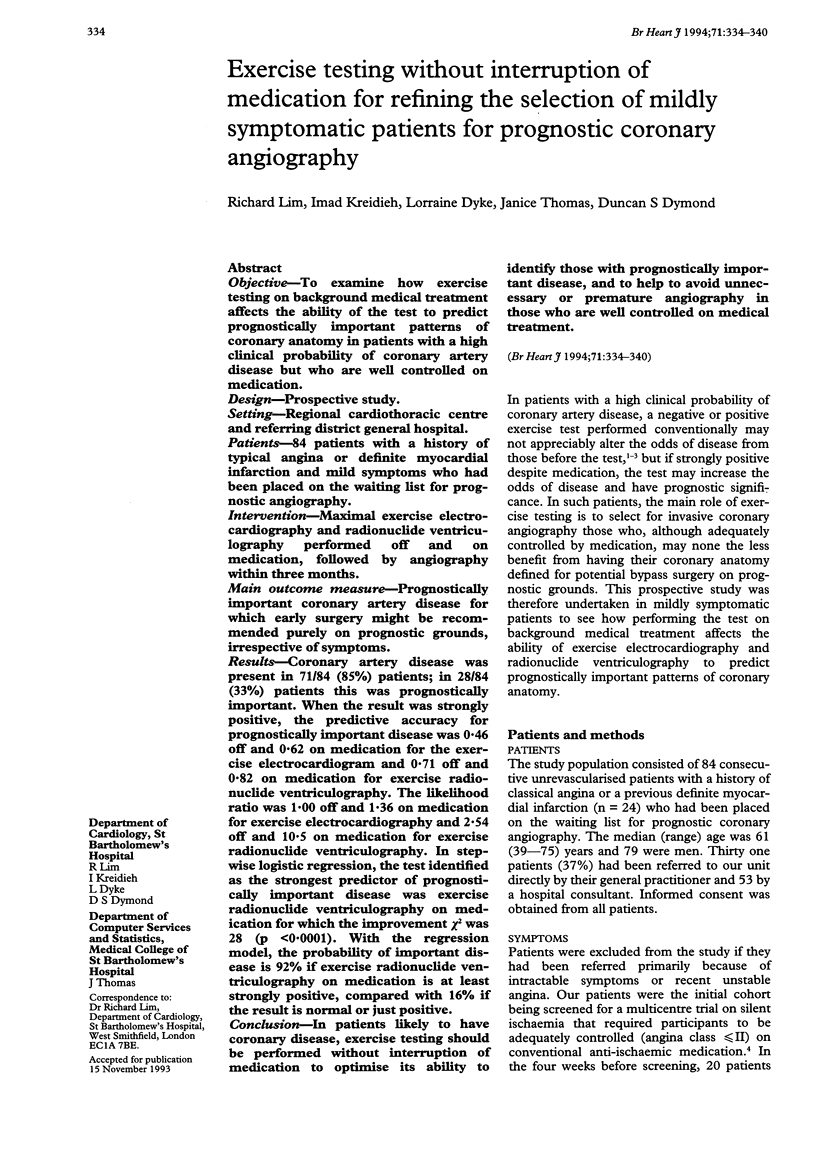
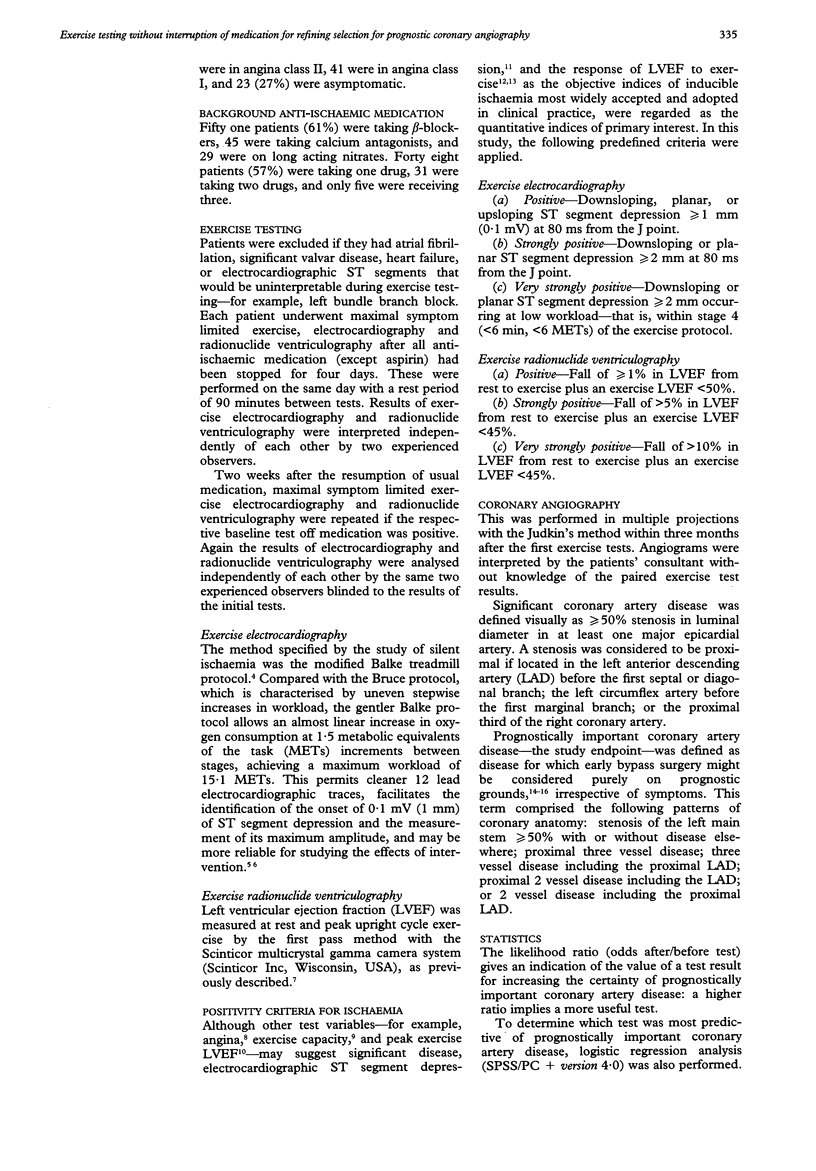
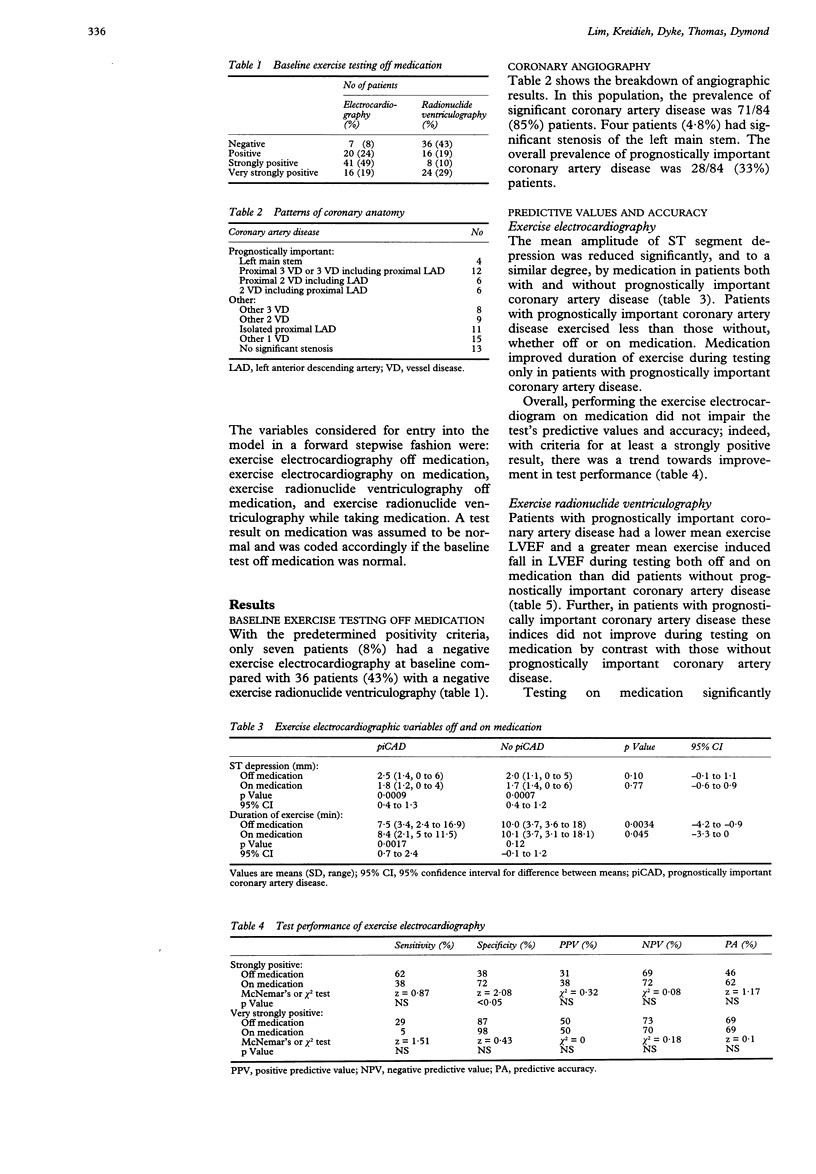
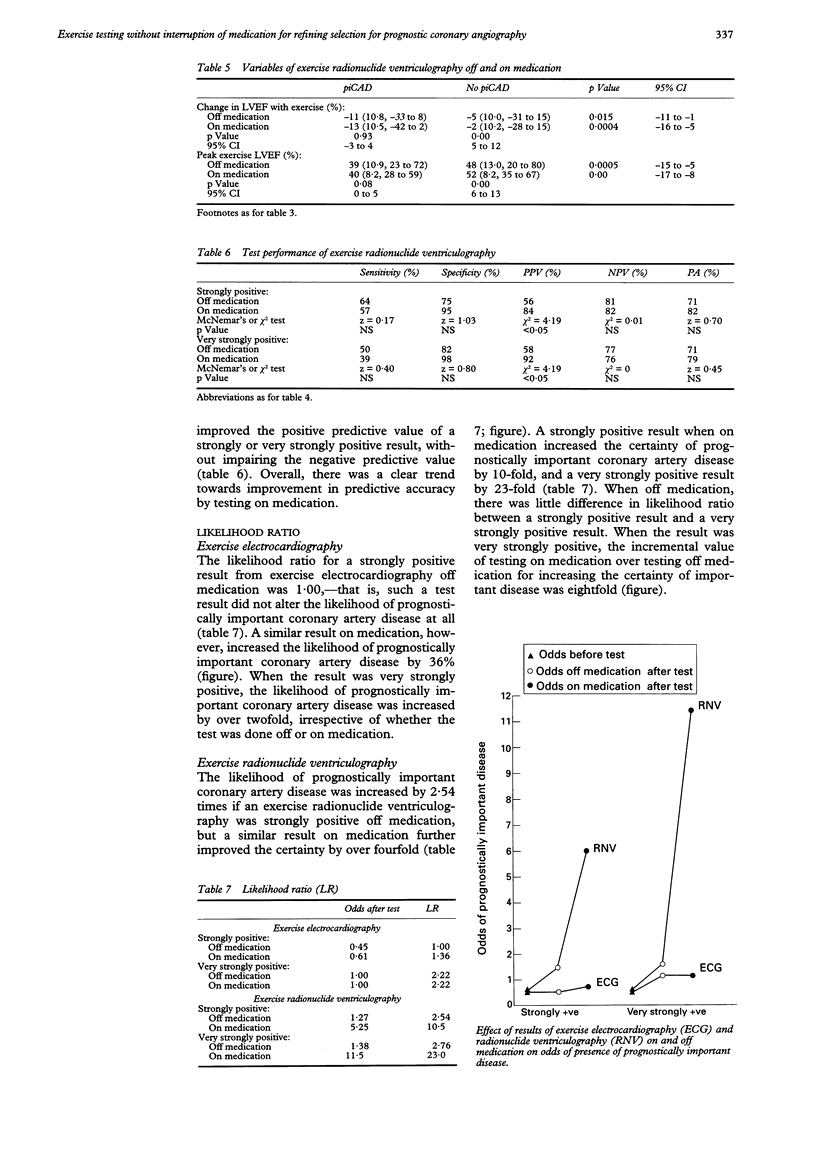
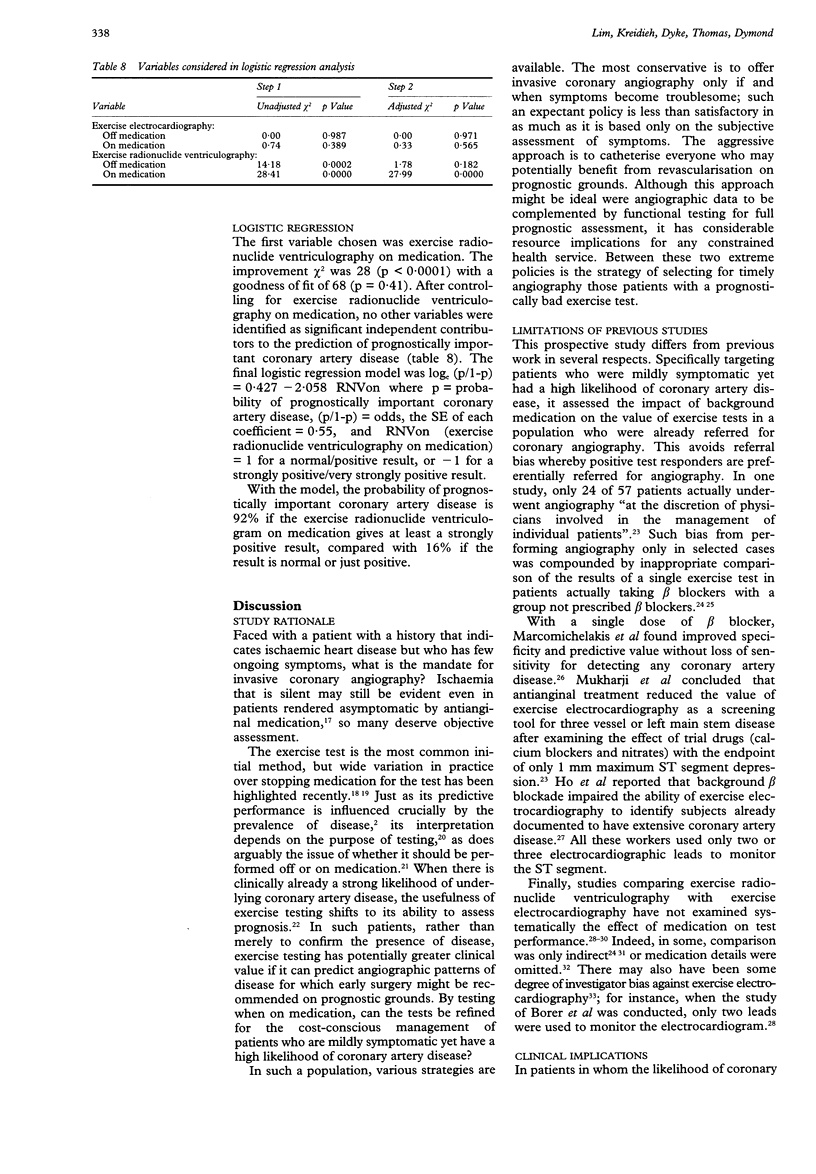
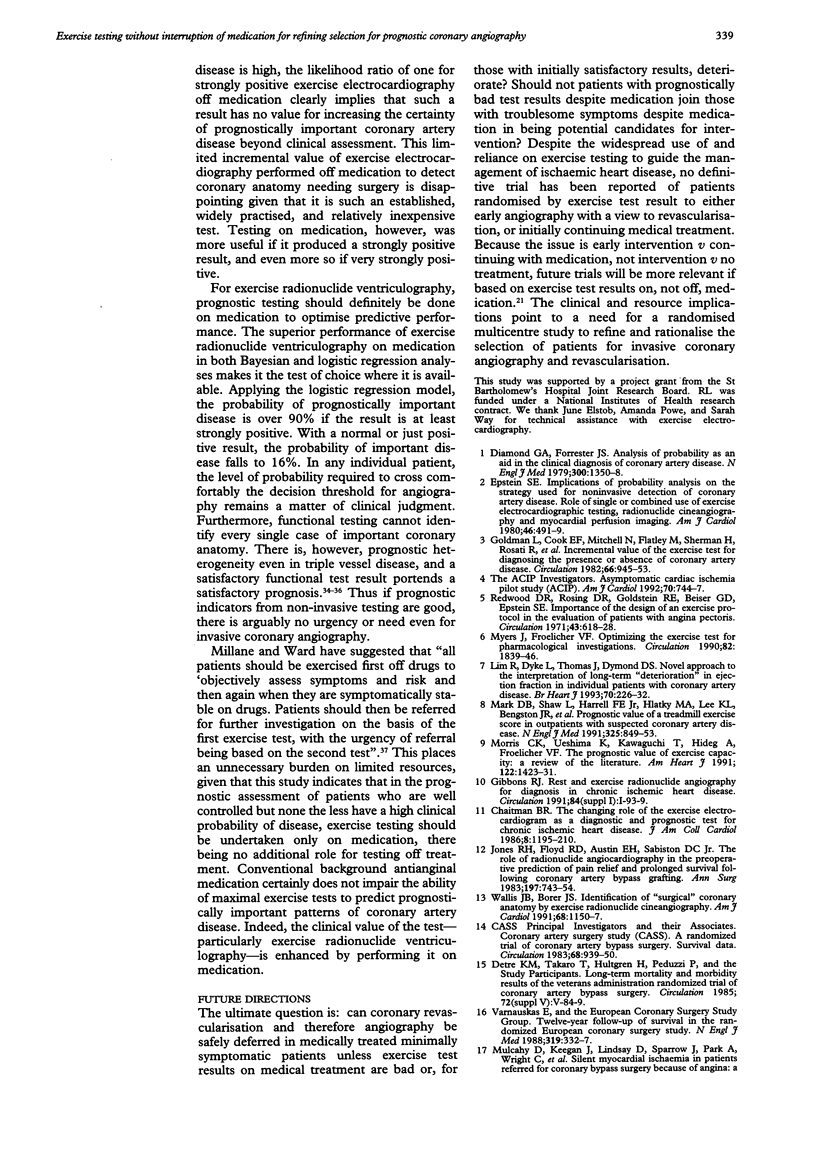
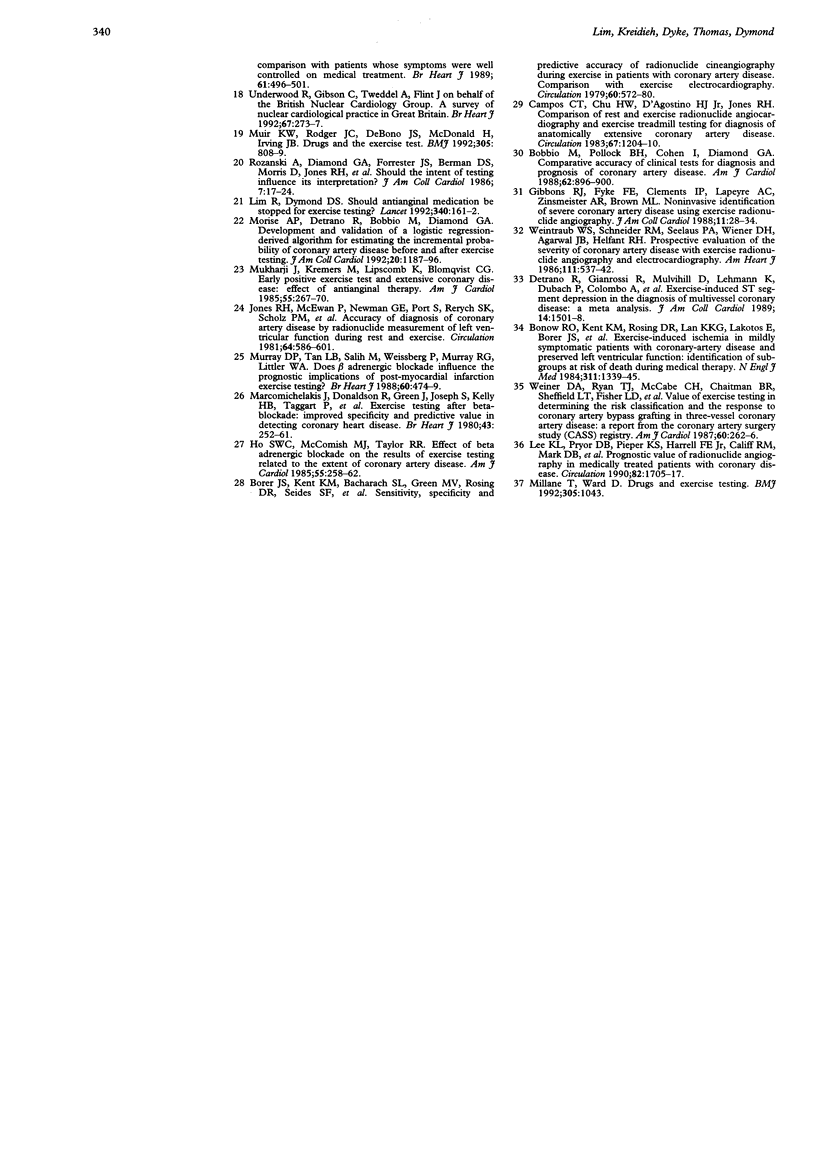
Selected References
These references are in PubMed. This may not be the complete list of references from this article.
- Bobbio M., Pollock B. H., Cohen I., Diamond G. A. Comparative accuracy of clinical tests for diagnosis and prognosis of coronary artery disease. Am J Cardiol. 1988 Nov 1;62(13):896–900. doi: 10.1016/0002-9149(88)90889-2. [DOI] [PubMed] [Google Scholar]
- Bonow R. O., Kent K. M., Rosing D. R., Lan K. K., Lakatos E., Borer J. S., Bacharach S. L., Green M. V., Epstein S. E. Exercise-induced ischemia in mildly symptomatic patients with coronary-artery disease and preserved left ventricular function. Identification of subgroups at risk of death during medical therapy. N Engl J Med. 1984 Nov 22;311(21):1339–1345. doi: 10.1056/NEJM198411223112103. [DOI] [PubMed] [Google Scholar]
- Borer J. S., Kent K. M., Bacharach S. L., Green M. V., Rosing D. R., Seides S. F., Epstein S. E., Johnston G. S. Sensitivity, specificity and predictive accuracy of radionuclide cineangiography during exercise in patients with coronary artery disease. Comparison with exercise electrocardiography. Circulation. 1979 Sep;60(3):572–580. doi: 10.1161/01.cir.60.3.572. [DOI] [PubMed] [Google Scholar]
- Campos C. T., Chu H. W., D'Agostino H. J., Jr, Jones R. H. Comparison of rest and exercise radionuclide angiocardiography and exercise treadmill testing for diagnosis of anatomically extensive coronary artery disease. Circulation. 1983 Jun;67(6):1204–1210. doi: 10.1161/01.cir.67.6.1204. [DOI] [PubMed] [Google Scholar]
- Chaitman B. R. The changing role of the exercise electrocardiogram as a diagnostic and prognostic test for chronic ischemic heart disease. J Am Coll Cardiol. 1986 Nov;8(5):1195–1210. doi: 10.1016/s0735-1097(86)80401-6. [DOI] [PubMed] [Google Scholar]
- Detrano R., Gianrossi R., Mulvihill D., Lehmann K., Dubach P., Colombo A., Froelicher V. Exercise-induced ST segment depression in the diagnosis of multivessel coronary disease: a meta analysis. J Am Coll Cardiol. 1989 Nov 15;14(6):1501–1508. doi: 10.1016/0735-1097(89)90388-4. [DOI] [PubMed] [Google Scholar]
- Diamond G. A., Forrester J. S. Analysis of probability as an aid in the clinical diagnosis of coronary-artery disease. N Engl J Med. 1979 Jun 14;300(24):1350–1358. doi: 10.1056/NEJM197906143002402. [DOI] [PubMed] [Google Scholar]
- Epstein S. E. Implications of probability analysis on the strategy used for noninvasive detection of coronary artery disease. Role of single or combined use of exercise electrocardiographic testing, radionuclide cineangiography and myocardial perfusion imaging. Am J Cardiol. 1980 Sep;46(3):491–499. doi: 10.1016/0002-9149(80)90020-x. [DOI] [PubMed] [Google Scholar]
- Gibbons R. J., Fyke F. E., 3rd, Clements I. P., Lapeyre A. C., 3rd, Zinsmeister A. R., Brown M. L. Noninvasive identification of severe coronary artery disease using exercise radionuclide angiography. J Am Coll Cardiol. 1988 Jan;11(1):28–34. doi: 10.1016/0735-1097(88)90162-3. [DOI] [PubMed] [Google Scholar]
- Goldman L., Cook E. F., Mitchell N., Flatley M., Sherman H., Rosati R., Harrell F., Lee K., Cohn P. F. Incremental value of the exercise test for diagnosing the presence or absence of coronary artery disease. Circulation. 1982 Nov;66(5):945–953. doi: 10.1161/01.cir.66.5.945. [DOI] [PubMed] [Google Scholar]
- Ho S. W., McComish M. J., Taylor R. R. Effect of beta-adrenergic blockade on the results of exercise testing related to the extent of coronary artery disease. Am J Cardiol. 1985 Feb 1;55(4):258–262. doi: 10.1016/0002-9149(85)90356-x. [DOI] [PubMed] [Google Scholar]
- Jones R. H., Floyd R. D., Austin E. H., Sabiston D. C., Jr The role of radionuclide angiocardiography in the preoperative prediction of pain relief and prolonged survival following coronary artery bypass grafting. Ann Surg. 1983 Jun;197(6):743–754. doi: 10.1097/00000658-198306000-00014. [DOI] [PMC free article] [PubMed] [Google Scholar]
- Jones R. H., McEwan P., Newman G. E., Port S., Rerych S. K., Scholz P. M., Upton M. T., Peter C. A., Austin E. H., Leong K. H. Accuracy of diagnosis of coronary artery disease by radionuclide management of left ventricular function during rest and exercise. Circulation. 1981 Sep;64(3):586–601. doi: 10.1161/01.cir.64.3.586. [DOI] [PubMed] [Google Scholar]
- Lee K. L., Pryor D. B., Pieper K. S., Harrell F. E., Jr, Califf R. M., Mark D. B., Hlatky M. A., Coleman R. E., Cobb F. R., Jones R. H. Prognostic value of radionuclide angiography in medically treated patients with coronary artery disease. A comparison with clinical and catheterization variables. Circulation. 1990 Nov;82(5):1705–1717. doi: 10.1161/01.cir.82.5.1705. [DOI] [PubMed] [Google Scholar]
- Lim R., Dyke L., Thomas J., Dymond D. S. Novel approach to the interpretation of long-term "deterioration" in ejection fraction in individual patients with coronary artery disease. Br Heart J. 1993 Sep;70(3):226–232. doi: 10.1136/hrt.70.3.226. [DOI] [PMC free article] [PubMed] [Google Scholar]
- Lim R., Dymond D. S. Should antianginal medication be stopped for exercise testing? Lancet. 1992 Jul 18;340(8812):161–162. doi: 10.1016/0140-6736(92)93226-d. [DOI] [PubMed] [Google Scholar]
- Marcomichelakis J., Donaldson R., Green J., Joseph S., Kelly H. B., Taggart P., Somerville W. Exercise testing after beta-blockade: improved specificity and predictive value in detecting coronary heart disease. Br Heart J. 1980 Mar;43(3):252–261. doi: 10.1136/hrt.43.3.252. [DOI] [PMC free article] [PubMed] [Google Scholar]
- Mark D. B., Shaw L., Harrell F. E., Jr, Hlatky M. A., Lee K. L., Bengtson J. R., McCants C. B., Califf R. M., Pryor D. B. Prognostic value of a treadmill exercise score in outpatients with suspected coronary artery disease. N Engl J Med. 1991 Sep 19;325(12):849–853. doi: 10.1056/NEJM199109193251204. [DOI] [PubMed] [Google Scholar]
- Millane T., Ward D. Drugs and exercise testing. BMJ. 1992 Oct 31;305(6861):1043–1043. doi: 10.1136/bmj.305.6861.1043. [DOI] [PMC free article] [PubMed] [Google Scholar]
- Morise A. P., Detrano R., Bobbio M., Diamond G. A. Development and validation of a logistic regression-derived algorithm for estimating the incremental probability of coronary artery disease before and after exercise testing. J Am Coll Cardiol. 1992 Nov 1;20(5):1187–1196. doi: 10.1016/0735-1097(92)90377-y. [DOI] [PubMed] [Google Scholar]
- Morris C. K., Ueshima K., Kawaguchi T., Hideg A., Froelicher V. F. The prognostic value of exercise capacity: a review of the literature. Am Heart J. 1991 Nov;122(5):1423–1431. doi: 10.1016/0002-8703(91)90586-7. [DOI] [PubMed] [Google Scholar]
- Muir K. W., Rodger J. C., DeBono J. S., McDonald H., Irving J. B. Drugs and the exercise test. BMJ. 1992 Oct 3;305(6857):808–809. doi: 10.1136/bmj.305.6857.808-a. [DOI] [PMC free article] [PubMed] [Google Scholar]
- Mukharji J., Kremers M., Lipscomb K., Blomqvist C. G. Early positive exercise test and extensive coronary disease: effect of antianginal therapy. Am J Cardiol. 1985 Feb 1;55(4):267–270. doi: 10.1016/0002-9149(85)90358-3. [DOI] [PubMed] [Google Scholar]
- Murray D. P., Tan L. B., Salih M., Weissberg P., Murray R. G., Littler W. A. Does beta adrenergic blockade influence the prognostic implications of post-myocardial infarction exercise testing? Br Heart J. 1988 Dec;60(6):474–479. doi: 10.1136/hrt.60.6.474. [DOI] [PMC free article] [PubMed] [Google Scholar]
- Myers J., Froelicher V. F. Optimizing the exercise test for pharmacological investigations. Circulation. 1990 Nov;82(5):1839–1846. doi: 10.1161/01.cir.82.5.1839. [DOI] [PubMed] [Google Scholar]
- Ralevic V., Burnstock G. Roles of P2-purinoceptors in the cardiovascular system. Circulation. 1991 Jul;84(1):1–14. doi: 10.1161/01.cir.84.1.1. [DOI] [PubMed] [Google Scholar]
- Redwood D. R., Rosing D. R., Goldstein R. E., Beiser G. D., Epstein S. E. Importance of the design of an exercise protocol in the evaluation of patients with angina pectoris. Circulation. 1971 May;43(5):618–628. doi: 10.1161/01.cir.43.5.618. [DOI] [PubMed] [Google Scholar]
- Rozanski A., Diamond G. A., Forrester J. S., Berman D. S., Morris D., Jones R. H., Okada R., Freeman M., Swan H. J. Should the intent of testing influence its interpretation? J Am Coll Cardiol. 1986 Jan;7(1):17–24. doi: 10.1016/s0735-1097(86)80252-2. [DOI] [PubMed] [Google Scholar]
- Underwood R., Gibson C., Tweddel A., Flint J. A survey of nuclear cardiological practice in Great Britain. The British Nuclear Cardiology Group. Br Heart J. 1992 Mar;67(3):273–277. doi: 10.1136/hrt.67.3.273. [DOI] [PMC free article] [PubMed] [Google Scholar]
- Varnauskas E. Twelve-year follow-up of survival in the randomized European Coronary Surgery Study. N Engl J Med. 1988 Aug 11;319(6):332–337. doi: 10.1056/NEJM198808113190603. [DOI] [PubMed] [Google Scholar]
- Wallis J. B., Borer J. S. Identification of "surgical" coronary anatomy by exercise radionuclide cineangiography. Am J Cardiol. 1991 Nov 1;68(11):1150–1157. doi: 10.1016/0002-9149(91)90186-o. [DOI] [PubMed] [Google Scholar]
- Weiner D. A., Ryan T. J., McCabe C. H., Chaitman B. R., Sheffield L. T., Fisher L. D., Tristani F. Value of exercise testing in determining the risk classification and the response to coronary artery bypass grafting in three-vessel coronary artery disease: a report from the Coronary Artery Surgery Study (CASS) registry. Am J Cardiol. 1987 Aug 1;60(4):262–266. doi: 10.1016/0002-9149(87)90224-4. [DOI] [PubMed] [Google Scholar]
- Weintraub W. S., Schneider R. M., Seelaus P. A., Wiener D. H., Agarwal J. B., Helfant R. H. Prospective evaluation of the severity of coronary artery disease with exercise radionuclide angiography and electrocardiography. Am Heart J. 1986 Mar;111(3):537–542. doi: 10.1016/0002-8703(86)90060-8. [DOI] [PubMed] [Google Scholar]


